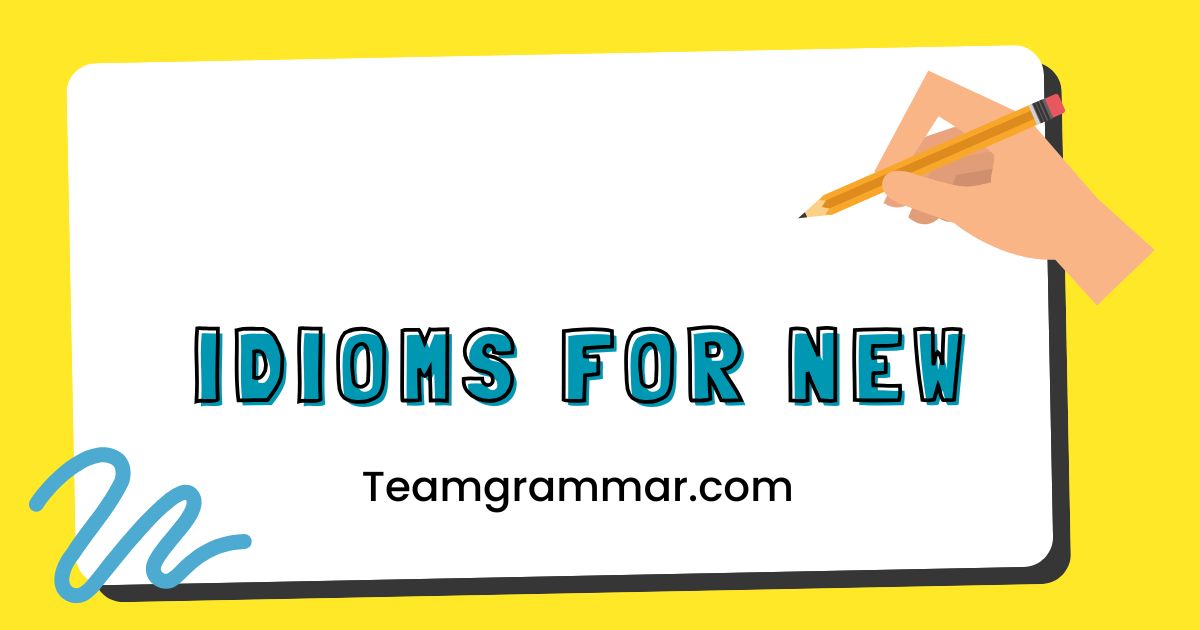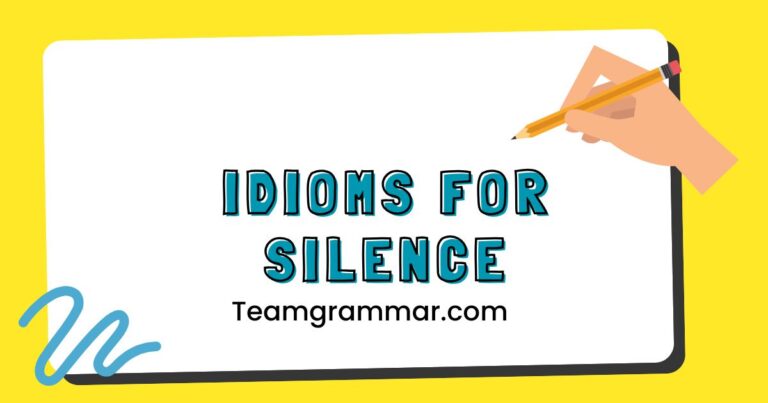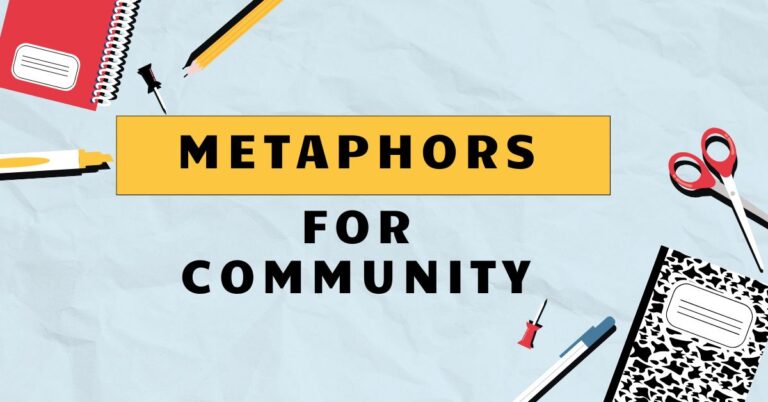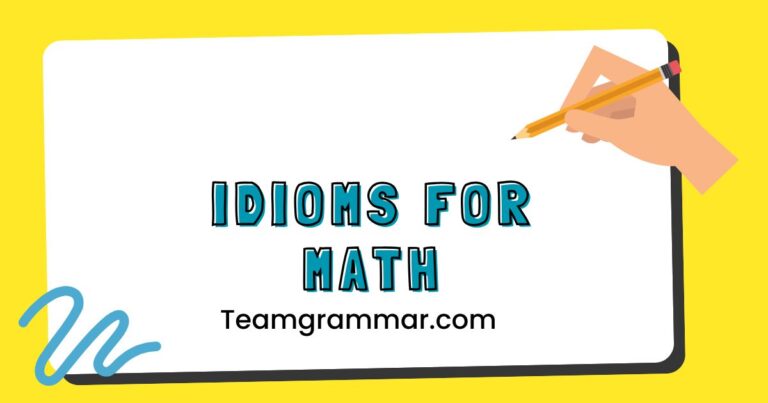39 Idioms for “New”: Mastering Nuance in English
Idioms add color and depth to the English language, allowing speakers to express complex ideas and emotions in a concise and evocative way. Mastering idioms, especially those related to the concept of “new,” is crucial for achieving fluency and understanding native speakers.
This article delves into a variety of idioms that incorporate the idea of “newness,” exploring their meanings, origins, and usage. Whether you’re an ESL student, a seasoned English speaker looking to refine your vocabulary, or simply someone fascinated by language, this guide will equip you with the knowledge to confidently use and interpret these colorful expressions.
Understanding idioms is not just about memorizing definitions; it’s about grasping the cultural context and subtle nuances that make them so effective. This comprehensive guide provides detailed explanations, examples, and practice exercises to help you integrate these idioms into your everyday communication, enhancing your ability to understand and engage with the English language on a deeper level.
Table of Contents
- Introduction
- Definition of Idioms
- Structural Breakdown of Idioms
- Categories of “New” Idioms
- Examples of Idioms for “New”
- Usage Rules for Idioms
- Common Mistakes with Idioms
- Practice Exercises
- Advanced Topics in Idioms
- Frequently Asked Questions
- Conclusion
Definition of Idioms
An idiom is a phrase or expression whose meaning cannot be understood from the ordinary meanings of the words in it. Idioms are a vital part of any language, adding richness and complexity to communication.
They often reflect cultural values, historical events, or common experiences. Understanding idioms requires not only vocabulary knowledge but also an understanding of the cultural context in which they are used.
Idioms are generally classified as non-compositional, meaning that the overall meaning of the phrase is different from the sum of its individual parts. For example, the idiom “kick the bucket” has nothing to do with literally kicking a bucket; it means “to die.” This non-compositional nature is what makes idioms challenging for language learners but also what makes them so expressive and interesting.
The function of idioms in language is multifaceted. They can be used to:
- Add emphasis or color to a statement.
- Express ideas in a concise and memorable way.
- Indicate familiarity and shared understanding between speakers.
- Convey subtle nuances of meaning that might be difficult to express directly.
Idioms are used in various contexts, from casual conversations to formal speeches, although some idioms are more appropriate for certain situations than others. It’s essential to consider the audience and the setting when using idioms to ensure that your message is well-received and understood.
Structural Breakdown of Idioms
While idioms are non-compositional in meaning, they still have a structural framework that can be analyzed. Understanding the structure of an idiom can sometimes help in remembering its meaning and using it correctly.
Idioms can take various forms, including:
- Phrasal Verbs: These consist of a verb and a preposition or adverb, such as “look up” (to research) or “give up” (to quit).
- Noun Phrases: These are idioms that function as nouns, such as “a piece of cake” (something easy) or “the last straw” (the final problem).
- Adjectival Phrases: These idioms function as adjectives, such as “brand new” (completely new) or “dead tired” (extremely tired).
- Complete Sentences: Some idioms are complete sentences, such as “It’s raining cats and dogs” (raining heavily) or “The ball is in your court” (it’s your turn to act).
The word order in idioms is generally fixed, meaning that the words cannot be rearranged without changing the meaning or making the idiom sound unnatural. For example, you can’t say “bucket the kick” and expect it to mean “to die.” The fixed word order is another characteristic that distinguishes idioms from ordinary phrases.
Furthermore, idioms often contain figurative language, such as metaphors, similes, and personification. These figures of speech contribute to the idiom’s non-literal meaning and its expressive power.
Recognizing the figurative language in an idiom can sometimes provide clues to its underlying meaning.
Categories of “New” Idioms
Idioms related to “new” can be categorized based on the specific aspect of newness they emphasize. Here are some categories:
- Fresh Start/Renewal: These idioms describe the beginning of something new, often implying a change for the better.
- Novelty/Unfamiliarity: These idioms focus on the experience of encountering something new or unknown.
- Innovation/Progress: These idioms relate to the creation of something new or the advancement of existing ideas.
- Condition/Quality: These idioms describe something that is in a new or pristine state.
Each category captures a different facet of the concept of “new,” allowing for a more nuanced understanding of the various idioms associated with it. By understanding these categories, learners can better appreciate the subtle differences in meaning and usage among these idioms.
Fresh Start/Renewal Idioms
These idioms emphasize new beginnings and opportunities for positive change. They often describe situations where someone is starting over or making a fresh start in their life.
Novelty/Unfamiliarity Idioms
These idioms focus on the experience of encountering something new, unknown, or unusual. They often describe situations where someone is facing a new challenge or exploring unfamiliar territory.
Innovation/Progress Idioms
These idioms relate to the creation of something new, the advancement of existing ideas, or the introduction of innovative solutions. They often describe situations where someone is pushing boundaries or making significant progress in a particular field.
Condition/Quality Idioms
These idioms describe something that is in a new, pristine, or improved state. They often emphasize the freshness, quality, or condition of an object or situation.
Examples of Idioms for “New”
Here are some examples of idioms related to “new,” categorized by their primary meaning:
Brand New
Meaning: Completely new; in perfect condition.
Example: “She bought a brand new car.”
The table below offers a variety of examples using the idiom “brand new” in different contexts.
| Example | Context |
|---|---|
| “He unwrapped a brand new phone.” | Describing a recently purchased electronic device. |
| “The house has a brand new roof.” | Referring to a recently installed roof on a house. |
| “She wore a brand new dress to the party.” | Describing clothing that has never been worn before. |
| “They launched a brand new marketing campaign.” | Referring to a newly developed marketing strategy. |
| “The company moved into a brand new office building.” | Describing a recently constructed or renovated office space. |
| “He started with a brand new notebook for his project.” | Describing the use of a fresh notebook for a new endeavor. |
| “The chef uses brand new ingredients every morning.” | Describing the freshness of ingredients. |
| “The software has a brand new interface.” | Referring to a redesigned user interface. |
| “The museum acquired a brand new exhibit.” | Describing a recently added exhibit. |
| “She felt like a brand new person after her vacation.” | Metaphorically describing a feeling of rejuvenation. |
| “The school introduced a brand new curriculum.” | Describing a recently implemented curriculum. |
| “He bought a brand new set of golf clubs.” | Referring to recently purchased sports equipment. |
| “The band released a brand new album.” | Describing a recently released music album. |
| “The city unveiled a brand new park.” | Referring to a recently opened public space. |
| “She started a brand new chapter in her life.” | Metaphorically describing a new phase in life. |
| “The restaurant opened with a brand new menu.” | Describing a recently introduced menu. |
| “The company developed a brand new technology.” | Referring to a recently developed technology. |
| “He received a brand new bicycle for his birthday.” | Describing a recently received gift. |
| “The project requires a brand new approach.” | Referring to a recently devised strategy. |
| “The team adopted a brand new strategy.” | Describing a new method or plan of action. |
| “The website has a brand new design.” | Referring to a recently updated website layout. |
| “The artist created a brand new series of paintings.” | Describing a recently created collection of artworks. |
| “The neighborhood has a brand new community center.” | Referring to a recently established community facility. |
| “The research team made a brand new discovery.” | Describing a recently made scientific finding. |
| “The bakery offers brand new flavors of ice cream.” | Referring to recently introduced ice cream flavors. |
New Lease on Life
Meaning: A chance to start over or improve one’s life.
Example: “After the surgery, he felt like he had a new lease on life.”
The following table provides example sentences for using the idiom “new lease on life.”
| Example | Context |
|---|---|
| “After recovering from his illness, he felt like he had a new lease on life.” | Describing a feeling of renewed health and vitality. |
| “Moving to the countryside gave her a new lease on life.” | Referring to a positive change in lifestyle. |
| “Retiring and pursuing his hobbies gave him a new lease on life.” | Describing a fulfilling transition after retirement. |
| “Adopting a pet gave the elderly woman a new lease on life.” | Referring to a renewed sense of purpose and companionship. |
| “After overcoming her addiction, she felt like she had a new lease on life.” | Describing a successful recovery from addiction. |
| “The old building got a new lease on life after the renovation.” | Referring to the restoration of a building. |
| “Learning a new skill gave him a new lease on life.” | Describing a renewed sense of purpose and accomplishment. |
| “After surviving the accident, she felt she had been given a new lease on life.” | Describing a feeling of gratitude after surviving a traumatic event. |
| “Volunteering at the shelter gave him a new lease on life.” | Referring to a renewed sense of purpose through helping others. |
| “She felt she had a new lease on life after leaving her stressful job.” | Describing a feeling of relief and freedom. |
| “The organization’s funding provided a new lease on life for their projects.” | Describing renewed support for projects. |
| “After the therapy, he felt like he had a new lease on life.” | Describing a positive outcome from therapy. |
| “The community garden gave the neighborhood a new lease on life.” | Referring to a restored sense of community. |
| “Taking up painting gave her a new lease on life.” | Describing a renewed passion for art. |
| “He felt like he had a new lease on life when he moved to a new city.” | Describing a feeling of excitement and opportunity. |
| “Her promotion at work gave her a new lease on life.” | Describing a boost in career satisfaction. |
| “After his surgery, he was grateful for his new lease on life.” | Expressing gratitude after a successful medical procedure. |
| “The funding allowed the charity to get a new lease on life.” | Describing how new funding revived the charity’s operations. |
| “She got a new lease on life when she started her own business.” | Describing increased satisfaction from entrepreneurship. |
| “They gave the old house a new lease on life with a complete renovation.” | Describing the restoration of an old property. |
New Kid on the Block
Meaning: Someone who is new to a place, group, or activity.
Example: “He’s the new kid on the block, so be nice to him.”
Here’s a table illustrating the use of “new kid on the block” in various scenarios.
| Example | Context |
|---|---|
| “She’s the new kid on the block in the office, so everyone is trying to make her feel welcome.” | Describing a new employee in a workplace. |
| “As the new kid on the block in the neighborhood, he made an effort to meet his neighbors.” | Referring to a new resident in a community. |
| “The tech startup is the new kid on the block, challenging established companies.” | Describing a new company entering the market. |
| “He’s the new kid on the block in the team, so he’s still learning the ropes.” | Referring to a new member of a sports team. |
| “She felt like the new kid on the block when she joined the book club.” | Describing a new member of a social group. |
| “Our company is the new kid on the block in the industry.” | Referring to a company that is new to the industry. |
| “He’s the new kid on the block in the class, so he’s a bit shy.” | Describing a new student in a classroom. |
| “She’s the new kid on the block in the gaming community.” | Referring to a new member of an online gaming group. |
| “As the new kid on the block, he had to prove himself to the older members.” | Describing a newcomer who needs to earn respect. |
| “He’s the new kid on the block and brings a fresh perspective to the project.” | Referring to a new team member with new ideas. |
| “Being the new kid on the block made her feel a bit out of place at first.” | Describing a feeling of unfamiliarity in a new environment. |
| “As the new kid on the block, he was keen to learn from the veterans.” | Referring to a newcomer eager to learn from experienced members. |
| “The band is the new kid on the block in the music scene.” | Referring to a new band on the music scene. |
| “She felt like the new kid on the block at the conference.” | Describing a feeling of being new at a professional event. |
| “He is the new kid on the block in the chess club.” | Referring to a new member of a chess club. |
| “As the new kid on the block, she was eager to make a good impression.” | Describing a desire to make a positive impact. |
| “The restaurant is the new kid on the block in the culinary scene.” | Referring to a new restaurant in town. |
| “Being the new kid on the block can be both exciting and challenging.” | Describing the mixed feelings of starting something new. |
| “The app is the new kid on the block in the social media world.” | Referring to a new app entering the market. |
| “He is the new kid on the block in the drama club.” | Referring to a new member of a drama club. |
| “As the new kid on the block, she was trying to find her place in the group.” | Describing the process of fitting in. |
| “The shop is the new kid on the block in the shopping district.” | Referring to a newly opened retail store. |
| “He felt like the new kid on the block when he started his new job.” | Describing the experience of starting a new job. |
| “She is the new kid on the block in the science competition.” | Referring to a new participant in a competition. |
Turn Over a New Leaf
Meaning: To make a fresh start and change one’s behavior for the better.
Example: “He decided to turn over a new leaf and quit smoking.”
The table below provides context and examples on how to use the “turn over a new leaf” idiom.
| Example | Context |
|---|---|
| “After his arrest, he promised to turn over a new leaf and stay out of trouble.” | Describing a commitment to change after a negative experience. |
| “She decided to turn over a new leaf and start eating healthier.” | Referring to a decision to adopt a healthier lifestyle. |
| “He wants to turn over a new leaf and become a better person.” | Describing a desire for personal improvement. |
| “They decided to turn over a new leaf in their marriage and communicate better.” | Referring to a commitment to improve a relationship. |
| “She resolved to turn over a new leaf and focus on her studies.” | Describing a renewed dedication to academic success. |
| “He decided to turn over a new leaf and stop procrastinating.” | Referring to a commitment to improve productivity. |
| “They wanted to turn over a new leaf and rebuild their reputation.” | Describing a desire to repair damaged trust. |
| “She planned to turn over a new leaf and spend more time with her family.” | Referring to a commitment to prioritize family relationships. |
| “He decided to turn over a new leaf and be more responsible with his finances.” | Describing a commitment to improve financial management. |
| “They promised to turn over a new leaf and create a more positive work environment.” | Referring to a commitment to improve workplace morale. |
| “She was determined to turn over a new leaf and overcome her bad habits.” | Describing a commitment to break negative patterns. |
| “He resolved to turn over a new leaf and be more punctual.” | Referring to a commitment to improve time management. |
| “They wanted to turn over a new leaf and strengthen their community ties.” | Describing a desire to improve social connections. |
| “She decided to turn over a new leaf and pursue her dreams.” | Referring to a renewed focus on personal goals. |
| “He resolved to turn over a new leaf and become a more active listener.” | Describing a commitment to improve communication skills. |
| “They wanted to turn over a new leaf and improve their customer service.” | Referring to a desire to enhance customer experience. |
| “She decided to turn over a new leaf and be more organized.” | Describing a commitment to improve personal organization. |
| “He resolved to turn over a new leaf and be more environmentally conscious.” | Referring to a commitment to sustainable living. |
| “They planned to turn over a new leaf and foster a more inclusive culture.” | Describing a desire to promote diversity and inclusion. |
| “She decided to turn over a new leaf and be more assertive in her career.” | Referring to a commitment to professional growth. |
Break New Ground
Meaning: To do something that has never been done before; to innovate.
Example: “His research is breaking new ground in the field of medicine.”
The table below provides various examples of the idiom “break new ground.”
| Example | Context |
|---|---|
| “Her research is breaking new ground in the field of artificial intelligence.” | Describing innovative research in AI. |
| “The company is breaking new ground with its sustainable energy solutions.” | Referring to innovative solutions for sustainable energy. |
| “His art is breaking new ground by combining traditional and modern techniques.” | Describing innovative artistic expression. |
| “The scientist is breaking new ground in the study of genetics.” | Referring to innovative research in genetics. |
| “The architect is breaking new ground with his eco-friendly designs.” | Describing innovative architectural designs. |
| “Their project is breaking new ground in urban planning.” | Referring to innovative solutions in urban development. |
| “The musician is breaking new ground by blending different genres.” | Describing innovative musical composition. |
| “The entrepreneur is breaking new ground with her social enterprise.” | Referring to innovative business models. |
| “The author is breaking new ground with his experimental writing style.” | Describing innovative literary techniques. |
| “The engineer is breaking new ground with her advancements in robotics.” | Referring to innovative developments in robotics. |
| “Her work is breaking new ground in understanding climate change.” | Describing innovative research on climate change. |
| “The organization is breaking new ground with its community development programs.” | Referring to innovative community initiatives. |
| “The dancer is breaking new ground by incorporating new styles into her choreography.” | Describing innovative dance techniques. |
| “The researcher is breaking new ground in the field of nanotechnology.” | Referring to innovative developments in nanotechnology. |
| “The filmmaker is breaking new ground with his documentary style.” | Describing innovative filmmaking techniques. |
| “The school is breaking new ground by implementing innovative teaching methods.” | Referring to innovative educational strategies. |
| “The athlete is breaking new ground with his training techniques.” | Describing innovative athletic training methods. |
| “The chef is breaking new ground by using unconventional ingredients.” | Referring to innovative culinary practices. |
| “The psychologist is breaking new ground in the treatment of mental health.” | Describing innovative therapeutic approaches. |
| “The company is breaking new ground with its revolutionary software.” | Referring to innovative software development. |
Usage Rules for Idioms
Using idioms correctly requires attention to several rules:
- Context: Ensure the idiom is appropriate for the situation and audience.
- Word Order: Maintain the fixed word order of the idiom.
- Tense: Adjust the verb tense within the idiom as needed.
- Pronouns: Use the correct pronouns to match the subject.
- Overuse: Avoid overusing idioms, as it can make your speech sound unnatural.
For example, you can change the tense of “turn over a new leaf” to “He turned over a new leaf last year,” but you cannot change the word order to “He turned a new leaf over.”
Common Mistakes with Idioms
One common mistake is taking idioms literally. For example, someone might misunderstand “break new ground” to mean physically digging in the earth.
Another frequent error is altering the word order or using the wrong tense. Here are some examples of correct and incorrect usage:
| Incorrect | Correct |
|---|---|
| “He is a new child on the block.” | “He is the new kid on the block.” |
| “She turned over a new tree.” | “She turned over a new leaf.” |
| “After surgery, I felt a new rent on life.” | “After surgery, I felt a new lease on life.” |
| “The company is breaking a new ground.” | “The company is breaking new ground.” |
| “He bought a new brand car.” | “He bought a brand new car.” |
Practice Exercises
Test your understanding of idioms with these exercises:
- Fill in the blank: After the accident, he felt like he had a ____ ____ ____ life.
- new rent on
- new lease on
- new lent on
Answer: b
- Which idiom means “to make a fresh start”?
- break new ground
- new kid on the block
- turn over a new leaf
Answer: c
- Complete the sentence: She’s the ____ ____ ____ ____ in the office, so be patient with her.
- new child on the block
- new kid on the block
- new person on the block
Answer: b
- Which sentence uses the idiom “brand new” correctly?
- He has a new brand car.
- He has a brand new car.
- He has a brand car new.
Answer: b
- What does “break new ground” mean?
- To physically dig in the earth.
- To do something innovative.
- To start a new garden.
Answer: b
- Fill in the blank: The company is ____ ____ ____ with its innovative technology.
- breaking a new ground
- breaking new ground
- breaking the new ground
Answer: b
- Which idiom suggests that someone is new to a place or group?
- Turn over a new leaf.
- New kid on the block.
- New lease on life.
Answer: b
- Complete the sentence: After quitting smoking, he decided to ____ ____ ____ ____ and adopt a healthier lifestyle.
- turn over a new tree
- turn over a new leaf
- turn over a new branch
Answer: b
- Which sentence uses the idiom “new lease on life” correctly?
- She got a new rent on life after her promotion.
- She got a new lease on life after her promotion.
- She got a new lead on life after her promotion.
Answer: b
- What is the meaning of “brand new”?
- Slightly used
- Completely new
- Old
Answer: b
Advanced Exercises:
- Write a short paragraph using at least three idioms related to “new.”
- Explain the origin of one of the idioms discussed in this article.
- Create a dialogue between two characters, using idioms related to “new” in a natural and appropriate way.
Advanced Topics in Idioms
For advanced learners, exploring the etymology and historical context of idioms can provide deeper insights into their meanings and usage. Additionally, understanding how idioms vary across different dialects of English can enhance communication skills.
Researching the cultural significance of idioms and their role in literature and popular culture can further enrich your understanding of the English language.
Also, consider the use of idioms in professional contexts. Certain industries may have their own specific set of idioms that are commonly used in business communication.
Learning these industry-specific idioms can be advantageous for career advancement.
Frequently Asked Questions
- What is the difference between an idiom and a proverb?
An idiom is a phrase whose meaning is not predictable from the usual meanings of its constituent elements, while a proverb is a short, well-known saying that expresses a general truth or piece of advice. Idioms are often figurative, while proverbs are more literal.
- How can I improve my understanding of idioms?
Read widely, listen to native speakers, and pay attention to the context in which idioms are used. Keep a notebook of new idioms you encounter and practice using them in your own speech and writing.
- Are idioms the same in all English-speaking countries?
No, idioms can
differ significantly between different English-speaking countries and regions. Some idioms are specific to certain dialects or cultures, while others are more widely understood.
- Is it okay to use idioms in formal writing?
It depends on the context and the audience. In general, it’s best to avoid overly casual or colloquial idioms in formal writing. However, some idioms are widely accepted and can add color and emphasis to your writing.
- How do I know when to use an idiom?
Consider the audience, the context, and your purpose. If you’re unsure whether an idiom is appropriate, it’s best to err on the side of caution and use more direct language.
Conclusion
Mastering idioms related to “new” can significantly enhance your understanding and use of the English language. By understanding the meanings, origins, and usage rules of these colorful expressions, you can communicate more effectively and connect with native speakers on a deeper level.
Keep practicing, and soon you’ll be using these idioms like a pro!







